小学英语外研版(一年级起点)二年级下册 Module 1 表格式教案(3个课时)
文档属性
| 名称 | 小学英语外研版(一年级起点)二年级下册 Module 1 表格式教案(3个课时) | 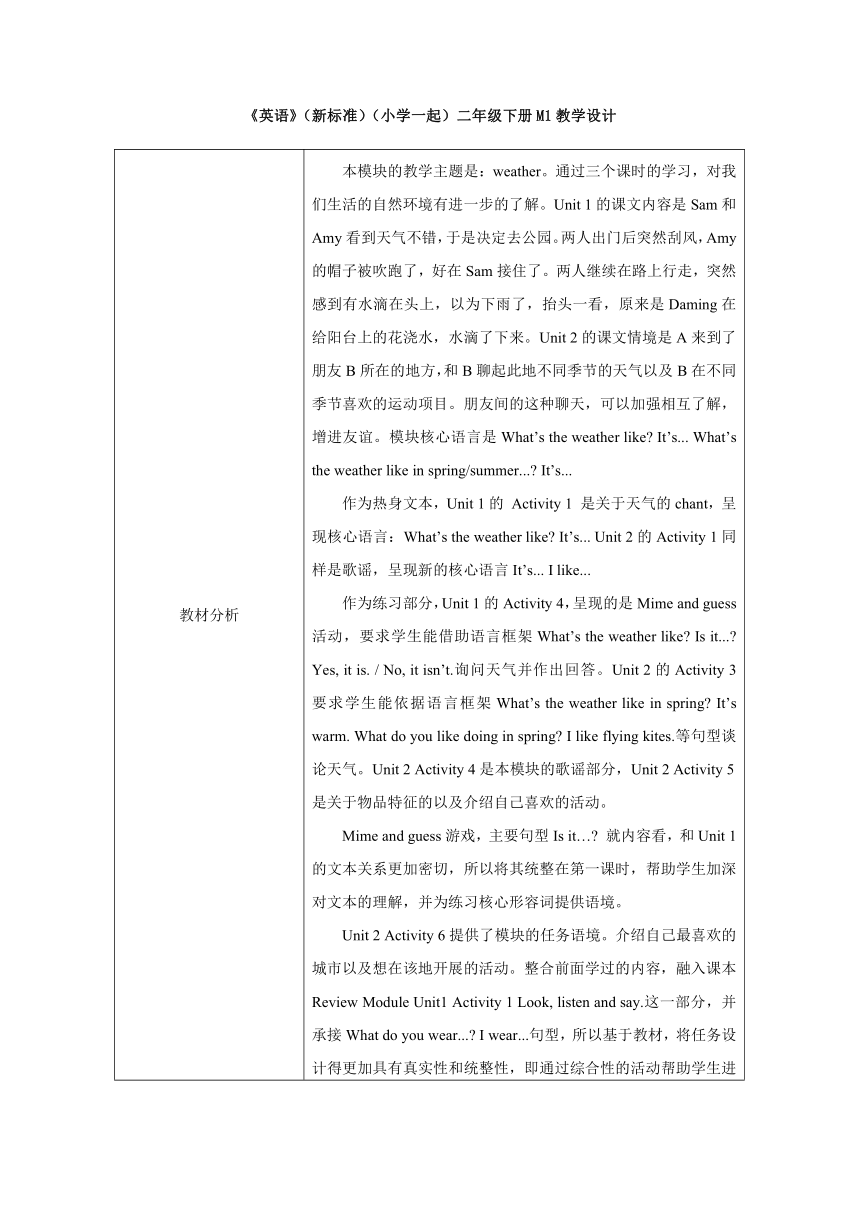 | |
| 格式 | doc | ||
| 文件大小 | 891.1KB | ||
| 资源类型 | 教案 | ||
| 版本资源 | 外研版(一年级起点) | ||
| 科目 | 英语 | ||
| 更新时间 | 2022-03-12 22:20:25 | ||
图片预览

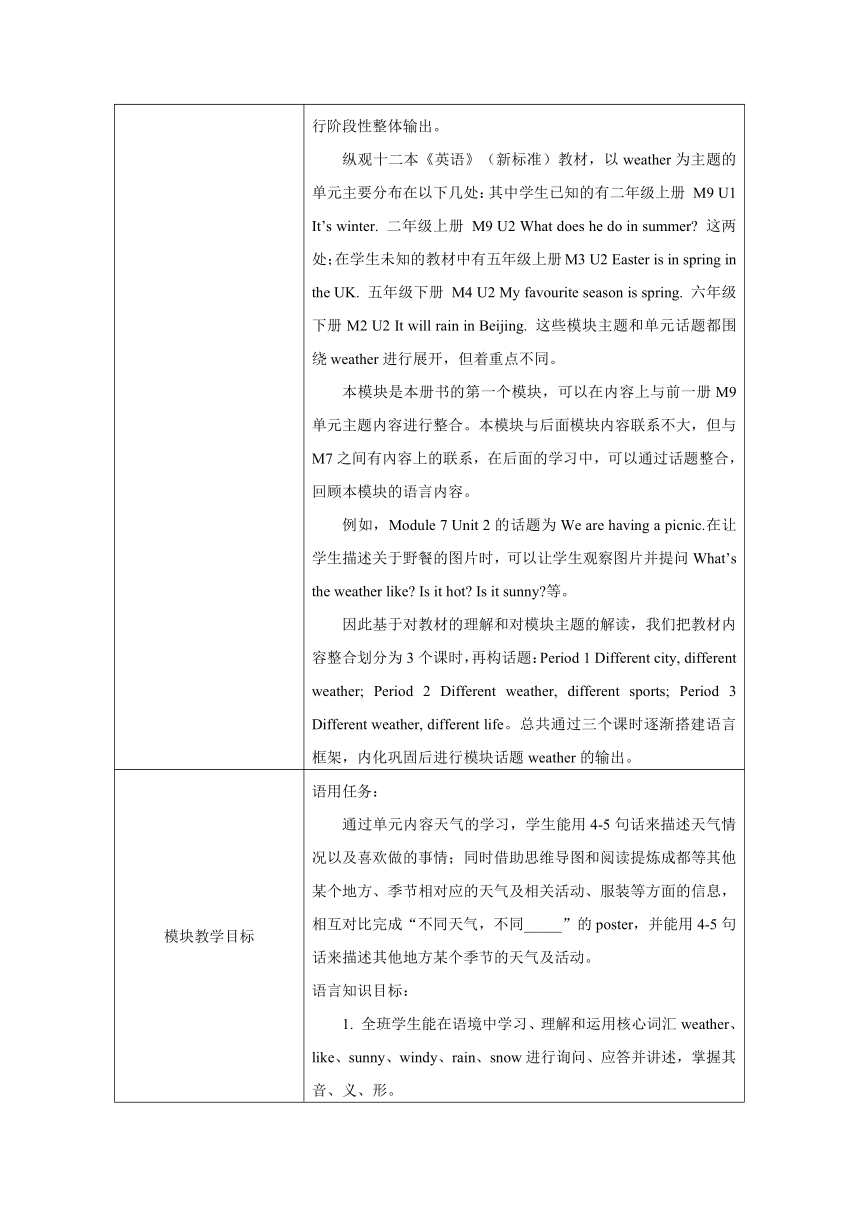
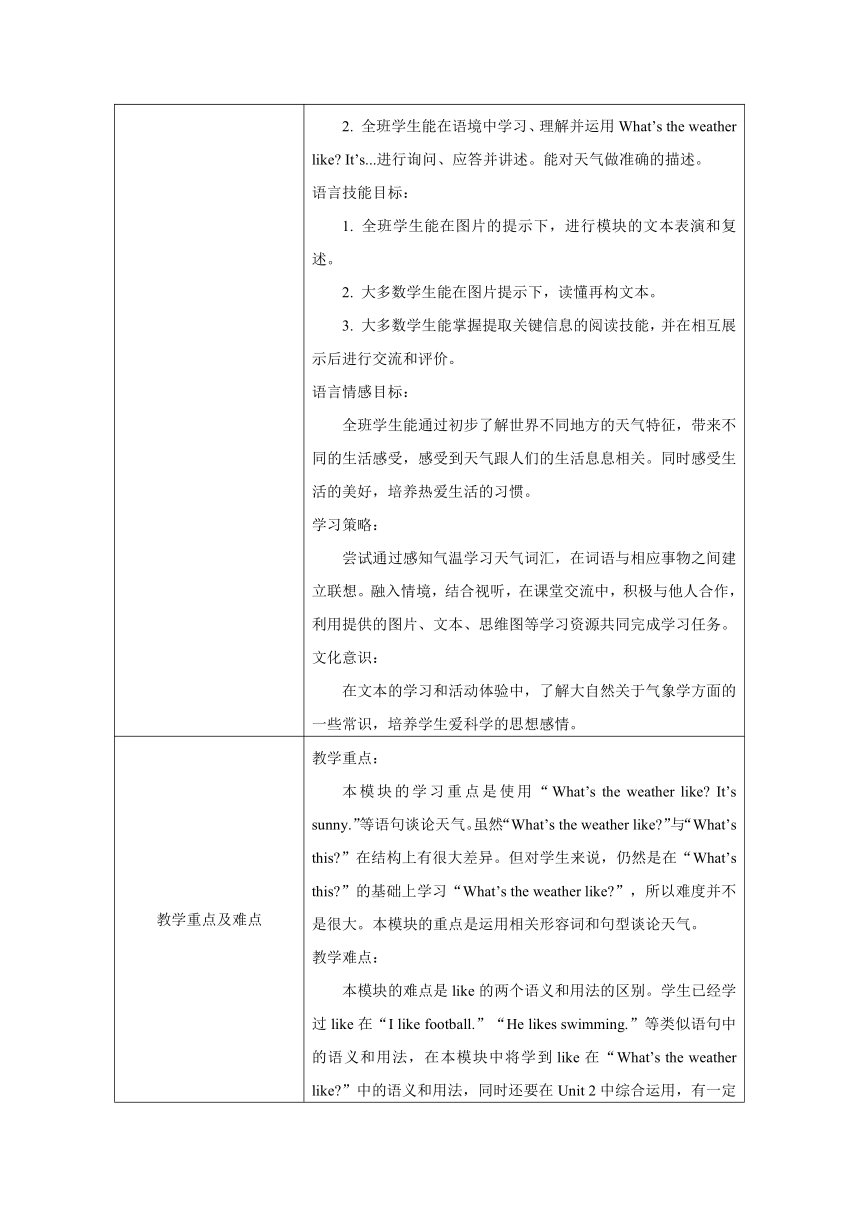
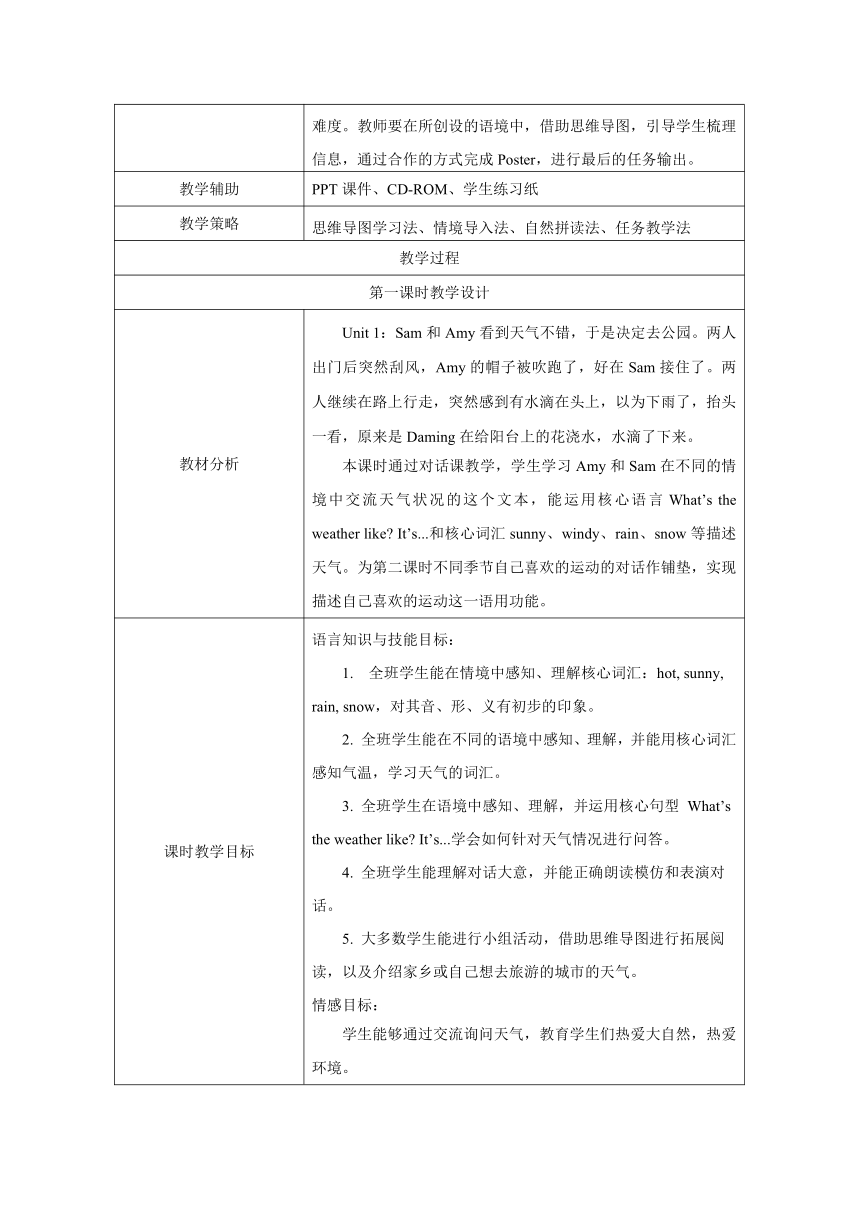
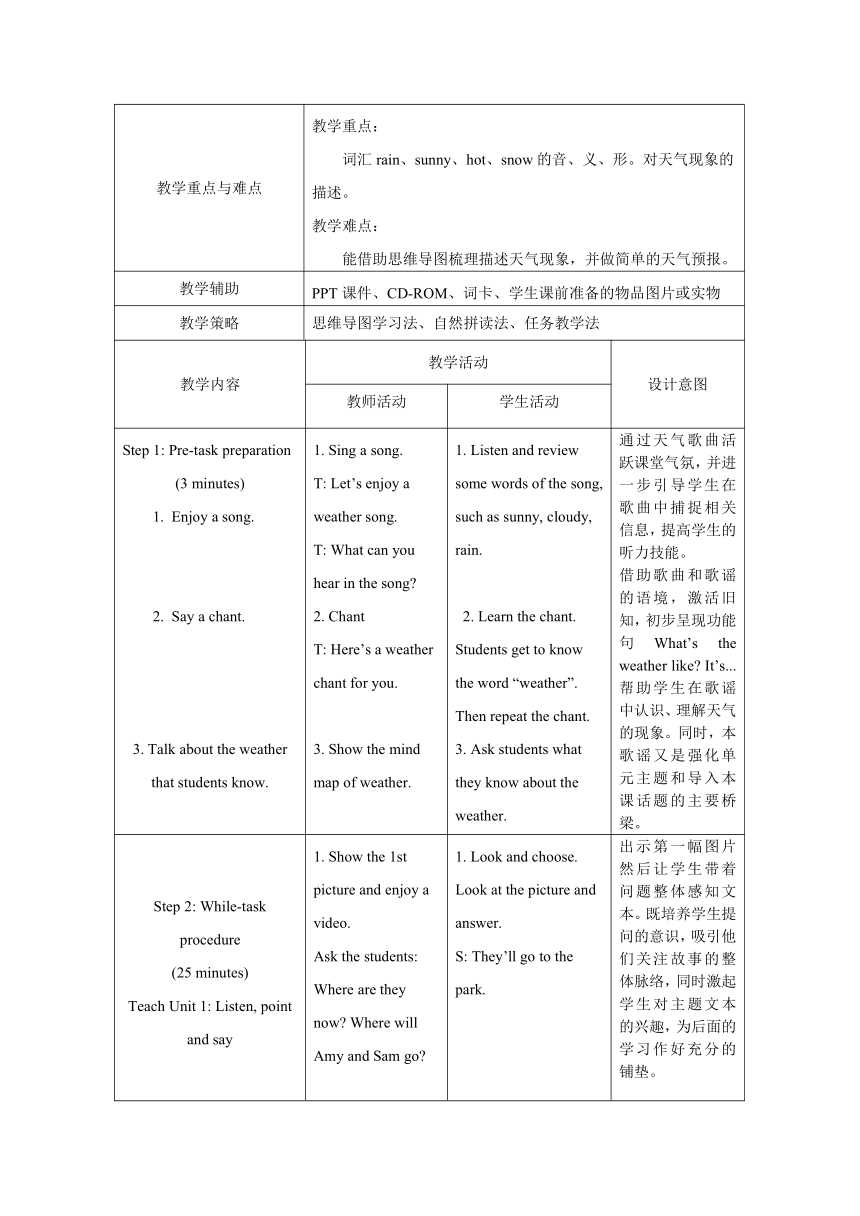
文档简介
《英语》(新标准)(小学一起)二年级下册M1教学设计
教材分析 本模块的教学主题是:weather。通过三个课时的学习,对我们生活的自然环境有进一步的了解。Unit 1的课文内容是Sam和Amy看到天气不错,于是决定去公园。两人出门后突然刮风,Amy的帽子被吹跑了,好在Sam接住了。两人继续在路上行走,突然感到有水滴在头上,以为下雨了,抬头一看,原来是Daming在给阳台上的花浇水,水滴了下来。Unit 2的课文情境是A来到了朋友B所在的地方,和B聊起此地不同季节的天气以及B在不同季节喜欢的运动项目。朋友间的这种聊天,可以加强相互了解,增进友谊。模块核心语言是What’s the weather like It’s... What’s the weather like in spring/summer... It’s...作为热身文本,Unit 1的 Activity 1 是关于天气的chant,呈现核心语言:What’s the weather like It’s... Unit 2的Activity 1同样是歌谣,呈现新的核心语言It’s... I like...作为练习部分,Unit 1的Activity 4,呈现的是Mime and guess活动,要求学生能借助语言框架What’s the weather like Is it... Yes, it is. / No, it isn’t.询问天气并作出回答。Unit 2的Activity 3要求学生能依据语言框架What’s the weather like in spring It’s warm. What do you like doing in spring I like flying kites.等句型谈论天气。Unit 2 Activity 4是本模块的歌谣部分,Unit 2 Activity 5是关于物品特征的以及介绍自己喜欢的活动。Mime and guess游戏,主要句型Is it… 就内容看,和Unit 1的文本关系更加密切,所以将其统整在第一课时,帮助学生加深对文本的理解,并为练习核心形容词提供语境。Unit 2 Activity 6提供了模块的任务语境。介绍自己最喜欢的城市以及想在该地开展的活动。整合前面学过的内容,融入课本Review Module Unit1 Activity 1 Look, listen and say.这一部分,并承接What do you wear... I wear...句型,所以基于教材,将任务设计得更加具有真实性和统整性,即通过综合性的活动帮助学生进行阶段性整体输出。纵观十二本《英语》(新标准)教材,以weather为主题的单元主要分布在以下几处:其中学生已知的有二年级上册 M9 U1 It’s winter. 二年级上册 M9 U2 What does he do in summer 这两处;在学生未知的教材中有五年级上册M3 U2 Easter is in spring in the UK. 五年级下册 M4 U2 My favourite season is spring. 六年级下册M2 U2 It will rain in Beijing. 这些模块主题和单元话题都围绕weather进行展开,但着重点不同。本模块是本册书的第一个模块,可以在内容上与前一册M9单元主题内容进行整合。本模块与后面模块内容联系不大,但与M7之间有內容上的联系,在后面的学习中,可以通过话题整合,回顾本模块的语言内容。例如,Module 7 Unit 2的话题为We are having a picnic.在让学生描述关于野餐的图片时,可以让学生观察图片并提问What’s the weather like Is it hot Is it sunny 等。因此基于对教材的理解和对模块主题的解读,我们把教材内容整合划分为3个课时,再构话题:Period 1 Different city, different weather; Period 2 Different weather, different sports; Period 3 Different weather, different life。总共通过三个课时逐渐搭建语言框架,内化巩固后进行模块话题weather的输出。
模块教学目标 语用任务:通过单元内容天气的学习,学生能用4-5句话来描述天气情况以及喜欢做的事情;同时借助思维导图和阅读提炼成都等其他某个地方、季节相对应的天气及相关活动、服装等方面的信息,相互对比完成“不同天气,不同_____”的poster,并能用4-5句话来描述其他地方某个季节的天气及活动。语言知识目标:全班学生能在语境中学习、理解和运用核心词汇weather、like、sunny、windy、rain、snow进行询问、应答并讲述,掌握其音、义、形。2. 全班学生能在语境中学习、理解并运用What’s the weather like It’s...进行询问、应答并讲述。能对天气做准确的描述。语言技能目标:1. 全班学生能在图片的提示下,进行模块的文本表演和复述。2. 大多数学生能在图片提示下,读懂再构文本。3. 大多数学生能掌握提取关键信息的阅读技能,并在相互展示后进行交流和评价。语言情感目标:全班学生能通过初步了解世界不同地方的天气特征,带来不同的生活感受,感受到天气跟人们的生活息息相关。同时感受生活的美好,培养热爱生活的习惯。学习策略:尝试通过感知气温学习天气词汇,在词语与相应事物之间建立联想。融入情境,结合视听,在课堂交流中,积极与他人合作,利用提供的图片、文本、思维图等学习资源共同完成学习任务。文化意识:在文本的学习和活动体验中,了解大自然关于气象学方面的一些常识,培养学生爱科学的思想感情。
教学重点及难点 教学重点:本模块的学习重点是使用“What’s the weather like It’s sunny.”等语句谈论天气。虽然“What’s the weather like ”与“What’s this ”在结构上有很大差异。但对学生来说,仍然是在“What’s this ”的基础上学习“What’s the weather like ”,所以难度并不是很大。本模块的重点是运用相关形容词和句型谈论天气。教学难点:本模块的难点是like的两个语义和用法的区别。学生已经学过like在“I like football.”“He likes swimming.”等类似语句中的语义和用法,在本模块中将学到like在“What’s the weather like ”中的语义和用法,同时还要在Unit 2中综合运用,有一定难度。教师要在所创设的语境中,借助思维导图,引导学生梳理信息,通过合作的方式完成Poster,进行最后的任务输出。
教学辅助 PPT课件、CD-ROM、学生练习纸
教学策略 思维导图学习法、情境导入法、自然拼读法、任务教学法
教学过程
第一课时教学设计
教材分析 Unit 1:Sam和Amy看到天气不错,于是决定去公园。两人出门后突然刮风,Amy的帽子被吹跑了,好在Sam接住了。两人继续在路上行走,突然感到有水滴在头上,以为下雨了,抬头一看,原来是Daming在给阳台上的花浇水,水滴了下来。本课时通过对话课教学,学生学习Amy和Sam在不同的情境中交流天气状况的这个文本,能运用核心语言What’s the weather like It’s...和核心词汇sunny、windy、rain、snow等描述天气。为第二课时不同季节自己喜欢的运动的对话作铺垫,实现 描述自己喜欢的运动这一语用功能。
课时教学目标 语言知识与技能目标: 全班学生能在情境中感知、理解核心词汇:hot, sunny, rain, snow,对其音、形、义有初步的印象。2. 全班学生能在不同的语境中感知、理解,并能用核心词汇感知气温,学习天气的词汇。3. 全班学生在语境中感知、理解,并运用核心句型 What’s the weather like It’s...学会如何针对天气情况进行问答。4. 全班学生能理解对话大意,并能正确朗读模仿和表演对话。5. 大多数学生能进行小组活动,借助思维导图进行拓展阅读,以及介绍家乡或自己想去旅游的城市的天气。情感目标:学生能够通过交流询问天气,教育学生们热爱大自然,热爱环境。
教学重点与难点 教学重点:词汇rain、sunny、hot、snow的音、义、形。对天气现象的描述。教学难点:能借助思维导图梳理描述天气现象,并做简单的天气预报。
教学辅助 PPT课件、CD-ROM、词卡、学生课前准备的物品图片或实物
教学策略 思维导图学习法、自然拼读法、任务教学法
教学内容 教学活动 设计意图
教师活动 学生活动
Step 1: Pre-task preparation (3 minutes)Enjoy a song.Say a chant.3. Talk about the weather that students know. 1. Sing a song.T: Let’s enjoy a weather song.T: What can you hear in the song 2. ChantT: Here’s a weather chant for you. 3. Show the mind map of weather. 1. Listen and review some words of the song, such as sunny, cloudy, rain. 2. Learn the chant. Students get to know the word “weather”. Then repeat the chant.3. Ask students what they know about the weather. 通过天气歌曲活跃课堂气氛,并进一步引导学生在歌曲中捕捉相关信息,提高学生的听力技能。借助歌曲和歌谣的语境,激活旧知,初步呈现功能句What’s the weather like It’s... 帮助学生在歌谣中认识、理解天气的现象。同时,本歌谣又是强化单元主题和导入本课话题的主要桥梁。
Step 2: While-task procedure(25 minutes)Teach Unit 1: Listen, point and say 1. Show the 1st picture and enjoy a video.Ask the students: Where are they now Where will Amy and Sam go 2. Show the 2nd picture. Ask the students: What’s the weather like 3. It’s hot and sunny. So what does Sam say Where’s Amy’s cap 4. Play the CD-ROM. And let students ask some questions.Teach the word windy and raining.Let the students think: Is it really raining What is Daming doing Will they go to the park Show some pictures with different kinds of weather. Let the students talk about them.5. Ask students to make a new information map. 1. Look and choose. Look at the picture and answer.S: They’ll go to the park.2. Watch the CD-ROM of Activity 2 and get the answer. Then repeat the key sentences.S: It’s hot. And it’s sunny.3. Watch and answer.S: Let’s take our caps.S: It’s on the sofa.4. Listen and follow the CD-ROM. Then let students ask some questions.e.g. Where are they now What’s the weather like 5. According to the pictures and key words, review the story. Then make a new information mind map about weather in pairs. 出示第一幅图片然后让学生带着问题整体感知文本。既培养学生提问的意识,吸引他们关注故事的整体脉络,同时激起学生对主题文本的兴趣,为后面的学习作好充分的铺垫。通过第二遍观看文本视频片段,初步在语境中了解本课时核心句型:What’s the weather like It’s...通过第三遍关注文本,问题驱动,以听答练习,观察图片,寻找相关信息,调动语言,进行表达。通过第四遍听读模仿文本视频,使学生在语境中思考问题,巩固所学内容,培养学生的语言表达能力。呈现不同天气的对比,学生可以进一步操练句型,从“练”中培养学生的思维能力,突显语用。教师和学生一起借助思维导图回顾文本内容,建构关于weather的信息结构图,在此过程中,帮助学生梳理整合信息,并逐渐从零散信息梳理成具有逻辑顺序的语序表达,体现生本智慧课堂。在此过程中,提供学生在合作学习中完成信息图的构建,初步培养学生的思维能力和合作能力。
Drillings about the text 1. Read and circle the weather words. 2. Let the students act out the dialogue in pairs.3. Mime and guess. 1. Read and circle the words: hot, sunny, windy, raining. 2. Act in pairs. 3. One student tries to choose 1 card to ask and mime from the blackboard. The others try to guess. 通过朗读和圈出关键词的方式,进一步熟悉文本内容,为输出做准备。通过模仿、朗读、表演等形式,在语篇环境中,强调升降调、重音,培养学生正确的朗读技能与习惯。通过生生互动,让学生在模仿和猜测中巩固和运用所学语言和知识,同时进一步感受到天气带来的影响。
Step 3: Post-task activities (11 minutes)Game: Students finish the weather cross in pairs. 2. Finish Activity 3, Page 3 of Activity Book. 3. Pair work: make a new dialogue.4. Group work: make a mind map 1. Let the students fill in the puzzle by using the pictures as clues. Find the correct spellings of words in the word bank.2. T: We know a lot about the UK’s weather. Now let’s get to know more different kinds of weather around us.3. The teacher invites students to enjoy some pictures about different cities in China. Then let them choose their favourite city and talk about the weather there.4. Output 1. Look at the pictures and find the correct answer by using the clues in pairs.2. Students try to listen and match. Then talk about it in pairs.3. Students get to know more about beautiful cities around them. Then they discuss in pairs. 4. Say something about the weather. 通过趣味游戏的方式,让学生在同伴合作中巩固并运用核心词汇、句型,锻炼学生分析和处理信息的能力,体验合作的乐趣。能在语境中,在图片和文字的帮助下,比较熟练地运用核心语言,激发学生自主表达的热情,从而感受天气的变化,同时感受到天气影响带给人们心情的变化。通过与他人共同参与课堂学习活动,在语言实践活动中思维碰撞,进一步培养学生的思维能力和语用能力。借助思维导图,让学生在情境中再次回顾本课的核心语言。
Step 4: Sum up (1 minute) What have you learnt today Song: Students look at the cartoon and say the weather.We’ll learn “Different weather, different sports” next class. 通过板书的思维导图再次回顾文本内容,整体关注话题点——如何描述天气,明确本课时话题。借助有趣的天气动画歌曲,引导学生思考和体会:仔细观察,你会发现更多。提出下课时的学习内容,渗透模块统整的理念,让学生初步了解模块话题,形成统整理念。
Classroom Assessment 教师口头评价;活动用书Unit 1 Activity 1反馈文本掌握情况;能否用2-3句描述天气完成本课时任务。 学习过程即时评价,通过口头评价、天气卡以及任务输出等多种形式,观察反馈学生对本课时的目标达成情况,学生初步尝试整合天气和季节相关的联系,为下课时的目标达成作铺垫。
家庭作业:1. Read the dialogue.2. Draw and describe the weather of the city you like.
板书设计: Module1 Unit 1 What’s the weather like What’s the weather like It’s sunny. It’s raining.
第二课时教学设计
教材分析 Unit 2的课文情境是A来到了朋友B所在的地方,和B聊起此地不同季节的天气以及在不同季节喜欢的运动项目。朋友间的这种聊天,可以加强相互了解,增进友谊。核心语言是What do you like doing in spring / summer / autumn / winter I like... v+ing.本课时通过对话教学,学生学习Unit 2关于季节与运动的话题,能运用What do you like doing in... I like... v+ing.表达自己的喜好,实现表达不同季节自己喜欢的运动的语用功能。相比第一课时,天气现象除了复习二年级上学期学过的四季,还增添了在不同季节人们喜欢的运动,以其为参考,学生能进一步巩固季节与天气的关系,并且通过了解不同的天气,带来不同的运动和生活习惯。借助绘本提供另外一个语境——Perfect kite weather,学生通过阅读绘本,拓展思维,感受到天气跟人们的生活息息相关,为第三课时整合不同天气,不同生活作好铺垫。
课时教学目标 知识目标:全班学生能听说读并在语境中运用词汇:sunny, windy, rain, snow。 2. 全班学生能朗读文本,听说认读:What do you like doing in summer/winter I like... v+ing. 大多数学生能在情景表演中描述不同季节喜欢的运动,完成Page 6 Activity 3。 技能目标:1. 全班学生能理解对话文本,看图描述对话。2. 大多数学生能在图片提示和老师的帮助下进行小组活动,描述不同天气和不同的活动。3. 大多数学生能感知绘本内容和情感,通过小组活动,回顾绘本进行填空练习,培养合作与探究的能力。情感目标:学生能够通过不同天气,感受到天气对人们生活带来的影响。通过绘本阅读,感受生活的多姿多态,培养热爱生活的情感。
教学重点与难点 教学重点:词汇skiing的音、义、形。词汇snows的发音。对不同天气喜欢活动的描述。教学难点:简单表达自己在不同季节喜欢的活动。
教学辅助 PPT课件、CD-ROM、学生练习纸
教学策略 借助图片或关键词,复述文本;通过活动用书的听力练习和绘本阅读,描述不同天气喜欢的活动,分层次练习、巩固核心语言点,强化文本内容。
教学内容(含时间设置) 教学活动 设计意图
教师活动 学生活动
Step 1: Pre-task preparation (5 minutes) 1. Free talk:T: What’s the weather like today T: Let’s review a chant.2. Listen and say a chant. 1. Review Unit 1 and chant last term.2. Enjoy a chant and then talk.T: What do you like doing in... Today we’re going to talk about weather. Different weather, different _______. 通过思维导图激活学生第一课时的思维图示,借助chant调动学生的思维,引导学生说出打篮球、踢足球、跑步等,为后面的学习做好充分的准备。通过听、观察、思考感知整个模块的主题:weather and sports。同时使学生带着好奇心,引起本课时与天气的关系,切实起到桥梁和纽带的作用。
Step 2: While-task procedure(20 minutes)1. Teach Unit 2. 1. Play the video of Unit 2 Activity 2.T: What’s the weather like What do you like doing in summer 2. Show the second picture of Activity 2. Then let the students ask 2 questions with “Wh-”.Teach the word “skiing”.3. Play the CD-ROM again. Ask the students to listen and imitate.4. Let the students fill in the blanks of the text.5. Retell the story with the help of the mind map. 1. Watch and answer.2. Look at the picture and ask 2 questions. Then get the answers. 3. Listen and imitate. Read in roles.Fill in the blanks on the PPT.5. Retell the text according to the key words on the PPT. 通过观看视频,整体感知文本。通过听、回答的方式,进一步掌握本课时的核心句型。借助图片,使学生在情境中运用核心语言。引导学生在文本中找到答案,培养学生自主提取有效信息的能力并表达。大量图片给学生造成视觉冲击,感受滑雪运动。通过朗读模仿关注学生良好的语言表达习惯。借助句型框架,分析整理相关文本信息,尝试表达中推进语言的习得情况。师生互动,梳理知识,完善思维导图,形成知识串,巩固核心知识。
2. Drillings about the text. 1. Look, ask and answer.Let the students choose the points according to their abilities.2. Let the students say a chant. 1. Choose the points according to their abilities. Then ask and answer in pairs.2. Listen and say. Then chant. 从学生的实际出发,让学生在情境中操练句型,以同伴合作为单位完成问答。四个情境不同的教学支架,照顾不同层次的学生,实现了从扶到放。借助视听方式,进一步感悟天气对人们生活的影响,通过歌谣的方式,引导学生在情境中感悟,在阅读中理解,在说唱中巩固。
Step 3: Post-task activities (14 minutes)Learn a new story. Let the students read a story. Enjoy the story.a. Read the story.b. Finish the reading response:Think and draw pictures. Then talk about them. 通过绘本阅读,学生在真实的情境中感知天气对人们生活的影响,同时培养学生养成良好的阅读习惯。通过reading response任务的驱动,检测本课时教学目标的达成度。
Step 4: Sum up (1 minute) T: What did you learn today 借助思维导图,梳理知识,拓展思维,培养学生综合语言运用能力。
Classroom Assessment 教师口头评价;活动用书Unit 2 Activity 1和Activity 2反馈文本掌握情况;能否用2-3句描述喜欢的运动完成本课时的活动。 通过口头评价、活动用书练习及任务输出,观察反馈学生对本课时的目标达成情况,学生逐步建立用核心语言描述喜欢的活动,为下课时的目标达成做准备。
家庭作业: 1. Listen to and imitate the text.2. Finish the new reading response.3. Enjoy a song.
板书设计: Module 1 Unit 2 I like swimming. What do you like doing I like swimming. I like skiing.
第三课时教学设计
教材分析 学生在本模块前两个课时的基础上,已经能够运用描述天气的形容词和I like...句型这些核心语言结构,描述天气现象以及在不同的天气季节喜欢做的活动,感受到天气与生活的关系。本课时教师通过整合文本,引导学生自己尝试通过读图和关键词的方式,采用小组合作共同讨论的方式回答教师提出的问题。教师从多个角度,多个层次,由低到高,鼓励学生提出简单问题,并通过开放性问题开拓学生的思维。在师生碰撞中,从多个方面逐渐帮助学生形成与天气话题相关的因素——衣服、季节等,形成思维导图,进一步让学生表达不同天气对人们生活的影响,丰富模块话题的内容,扩展语用功能。基于二年级学生的年龄特点,针对学生语言特点,逐渐提高学生的话语能力。通过本课时,完成提升本模块话题内涵的任务。
课时教学目标 知识目标:全班学生能听说读写并在情境中运用词汇:sunny, windy, rain, snow。 2. 全班学生能朗读关于天气的文本故事。大多数学生能听说读写:What’s the weather like It’s... What do you like doing in... I like...技能目标:1. 全班学生能在图片的提示下,在情境中进行模块的文本表演和复述。2. 大多数学生能在图片关键词的提示下,读懂小故事,进一步在情境中理解天气与生活息息相关。3. 大多数学生能在小组合作中完成关于天气的report,并且相互分享后评价。情感目标:通过了解不同的天气现象对人们的生活会带来不同的影响,培养学生热爱生活、观察生活的能力。
教学重点与难点 教学重点:整理总结关于天气的相关话题,及时内化核心语言,输出本模块的内容。教学难点:在语境中正确理解、巩固运用核心句型It’s… I like...谈论天气。
教学辅助 PPT课件、CD-ROM、学生练习纸
教学策略 通过表演、复述,复习模块文本。通过阅读整合梳理的文本,培养学生热爱阅读兴趣,提高学生通过图片或关键点的方式阅读的能力;借助提问,巧妙帮助学生复习旧知,激活思维,发展学生思维的能力;凭借梳理核心内容,帮助学生形成整体思维的意识,内化语言知识,输出本模块的内容。最后通过模块话题的表达,对天气现象和喜欢的活动做整体的表述,初步形成分析和统整能力。
教学内容(含时间设置) 教学活动 设计意图
教师活动 学生活动
Step 1: Pre-task preparation (5 minutes)Review the 2 texts of Module 1. 1. Let the students act out the dialogue of Unit 1.2. Show the pictures of the 2 texts. 1. Act out the dialogue.2. Retell the texts of Unit1 and Unit 2.a. Fill in the blanks: Different city, different weather.b. Look and say: Different weather, different sports. 通过表演、填空、复述等方式复习前两课时的语篇,巩固核心词汇和句型,并进行语言输出,突显语用。
Step 2: While-task procedure(18 minutes)Elicit a new story. 1. Enjoy a new story: I am a bunny.a. Let students observe the cover. Then ask the students questions: Who is bunny What is it doing What’s the weather like b. Let students predict the story.2. Let the students read the story. Encourage students to ask more questions about the text.3. Let the students read the whole story together. Then check.4. Let the students retell the story.5. Let the students rename the story. 1. Read and looka. Look and say. b. Look and guess.2. Read Bunny’s story. Think and talk.Then ask and answer the questions.3. Read the story together. Then match the pictures.Students try to talk about the story.5. Sum up the topic. 通过封面引导学生观察图片,借助简单性问题启发学生思考。鼓励学生预测故事的发展内容,激发学生的想象力,为下面的学习作好铺垫。通过简单的图片和文字鼓励学生自主阅读故事,思考故事内容。通过问题的引导,帮助学生梳理发展脉络,提高学生思维能力,发展学生的想象能力。通过提供文本支架,进一步帮助学生在情境中巩固核心语言。借助文本,让学生在情境中反馈习得的知识,借助关键内容,提高学生的阅读能力。
Step 3: Post-task activities (16 minutes)1. Feedback of yesterday’s homework. 2. Do and say 3. Sum up 1. Show the students’ homework.Then correct someone’s homework in class. 2. Introduce your favorite city.3. Let the students finish the map. Choose the card. Stick the card. Talk about the map in groups. 1. Yesterday’s homework show.a. Write more about the weather. e.g. What do you wear in... b. Some students show their homework and correct the mistakes in class. 2. Enjoy some pictures. Students show a picture of the city they like and discuss in groups.3. Finish the bubble map.a. Choose the right card.b. Stick the card into the right position.c. Talk about the map in groups. 通过回顾上课时的实践作业,帮助学生理清重难点,同时提出引导性问题,启发学生联想过去学过的内容,培养学生逻辑思维能力。通过学生互相转述,分享作业的方式,既帮助学生巩固第三人称的表达方式,又引导学生进一步在真实的情境中提高语言运用能力。承接课本活动任务6的活动,让学生在欣赏不同地区、不同天气、不同生活的照片情境中,结合本模块所学的内容综合性运用语言,进行阶段性整体输出。最后通过泡泡图,帮助学生形成关于模块话题的整体思维,提高学生归纳整合能力。
Step 4: Sum up (1 minute) T: When we talk about the weather, what should we know 通过学生自己总结,观察学生是否能够内化所学的知识,达成本模块的语用目的。
Classroom Assessment 教师口头评价;当堂修改学生作业中的错误,反馈书写情况;学生能否内化关于天气话题的讨论,用4-5句话进行描述。 通过前置性作业,观察学生的易错点并给予及时的纠正;通过思维导图的制作,内化学生的语言,及时输出本单元的内容。
家庭作业:1. Finish a report: My favorite city.2. Make a new story: Different weather, different life.
板书设计: Module 1 Different weather, different life.What’s the weather like here It’s...What do you like doing I like...
hot
cold
weather
rainy
snowy
swim
ski
ski
swim
cold
hot
sports
sports
weather
fly kites
play football
fly kites
play football
rainy
snowy
city
clothes
weather
good
sports
bad
教材分析 本模块的教学主题是:weather。通过三个课时的学习,对我们生活的自然环境有进一步的了解。Unit 1的课文内容是Sam和Amy看到天气不错,于是决定去公园。两人出门后突然刮风,Amy的帽子被吹跑了,好在Sam接住了。两人继续在路上行走,突然感到有水滴在头上,以为下雨了,抬头一看,原来是Daming在给阳台上的花浇水,水滴了下来。Unit 2的课文情境是A来到了朋友B所在的地方,和B聊起此地不同季节的天气以及B在不同季节喜欢的运动项目。朋友间的这种聊天,可以加强相互了解,增进友谊。模块核心语言是What’s the weather like It’s... What’s the weather like in spring/summer... It’s...作为热身文本,Unit 1的 Activity 1 是关于天气的chant,呈现核心语言:What’s the weather like It’s... Unit 2的Activity 1同样是歌谣,呈现新的核心语言It’s... I like...作为练习部分,Unit 1的Activity 4,呈现的是Mime and guess活动,要求学生能借助语言框架What’s the weather like Is it... Yes, it is. / No, it isn’t.询问天气并作出回答。Unit 2的Activity 3要求学生能依据语言框架What’s the weather like in spring It’s warm. What do you like doing in spring I like flying kites.等句型谈论天气。Unit 2 Activity 4是本模块的歌谣部分,Unit 2 Activity 5是关于物品特征的以及介绍自己喜欢的活动。Mime and guess游戏,主要句型Is it… 就内容看,和Unit 1的文本关系更加密切,所以将其统整在第一课时,帮助学生加深对文本的理解,并为练习核心形容词提供语境。Unit 2 Activity 6提供了模块的任务语境。介绍自己最喜欢的城市以及想在该地开展的活动。整合前面学过的内容,融入课本Review Module Unit1 Activity 1 Look, listen and say.这一部分,并承接What do you wear... I wear...句型,所以基于教材,将任务设计得更加具有真实性和统整性,即通过综合性的活动帮助学生进行阶段性整体输出。纵观十二本《英语》(新标准)教材,以weather为主题的单元主要分布在以下几处:其中学生已知的有二年级上册 M9 U1 It’s winter. 二年级上册 M9 U2 What does he do in summer 这两处;在学生未知的教材中有五年级上册M3 U2 Easter is in spring in the UK. 五年级下册 M4 U2 My favourite season is spring. 六年级下册M2 U2 It will rain in Beijing. 这些模块主题和单元话题都围绕weather进行展开,但着重点不同。本模块是本册书的第一个模块,可以在内容上与前一册M9单元主题内容进行整合。本模块与后面模块内容联系不大,但与M7之间有內容上的联系,在后面的学习中,可以通过话题整合,回顾本模块的语言内容。例如,Module 7 Unit 2的话题为We are having a picnic.在让学生描述关于野餐的图片时,可以让学生观察图片并提问What’s the weather like Is it hot Is it sunny 等。因此基于对教材的理解和对模块主题的解读,我们把教材内容整合划分为3个课时,再构话题:Period 1 Different city, different weather; Period 2 Different weather, different sports; Period 3 Different weather, different life。总共通过三个课时逐渐搭建语言框架,内化巩固后进行模块话题weather的输出。
模块教学目标 语用任务:通过单元内容天气的学习,学生能用4-5句话来描述天气情况以及喜欢做的事情;同时借助思维导图和阅读提炼成都等其他某个地方、季节相对应的天气及相关活动、服装等方面的信息,相互对比完成“不同天气,不同_____”的poster,并能用4-5句话来描述其他地方某个季节的天气及活动。语言知识目标:全班学生能在语境中学习、理解和运用核心词汇weather、like、sunny、windy、rain、snow进行询问、应答并讲述,掌握其音、义、形。2. 全班学生能在语境中学习、理解并运用What’s the weather like It’s...进行询问、应答并讲述。能对天气做准确的描述。语言技能目标:1. 全班学生能在图片的提示下,进行模块的文本表演和复述。2. 大多数学生能在图片提示下,读懂再构文本。3. 大多数学生能掌握提取关键信息的阅读技能,并在相互展示后进行交流和评价。语言情感目标:全班学生能通过初步了解世界不同地方的天气特征,带来不同的生活感受,感受到天气跟人们的生活息息相关。同时感受生活的美好,培养热爱生活的习惯。学习策略:尝试通过感知气温学习天气词汇,在词语与相应事物之间建立联想。融入情境,结合视听,在课堂交流中,积极与他人合作,利用提供的图片、文本、思维图等学习资源共同完成学习任务。文化意识:在文本的学习和活动体验中,了解大自然关于气象学方面的一些常识,培养学生爱科学的思想感情。
教学重点及难点 教学重点:本模块的学习重点是使用“What’s the weather like It’s sunny.”等语句谈论天气。虽然“What’s the weather like ”与“What’s this ”在结构上有很大差异。但对学生来说,仍然是在“What’s this ”的基础上学习“What’s the weather like ”,所以难度并不是很大。本模块的重点是运用相关形容词和句型谈论天气。教学难点:本模块的难点是like的两个语义和用法的区别。学生已经学过like在“I like football.”“He likes swimming.”等类似语句中的语义和用法,在本模块中将学到like在“What’s the weather like ”中的语义和用法,同时还要在Unit 2中综合运用,有一定难度。教师要在所创设的语境中,借助思维导图,引导学生梳理信息,通过合作的方式完成Poster,进行最后的任务输出。
教学辅助 PPT课件、CD-ROM、学生练习纸
教学策略 思维导图学习法、情境导入法、自然拼读法、任务教学法
教学过程
第一课时教学设计
教材分析 Unit 1:Sam和Amy看到天气不错,于是决定去公园。两人出门后突然刮风,Amy的帽子被吹跑了,好在Sam接住了。两人继续在路上行走,突然感到有水滴在头上,以为下雨了,抬头一看,原来是Daming在给阳台上的花浇水,水滴了下来。本课时通过对话课教学,学生学习Amy和Sam在不同的情境中交流天气状况的这个文本,能运用核心语言What’s the weather like It’s...和核心词汇sunny、windy、rain、snow等描述天气。为第二课时不同季节自己喜欢的运动的对话作铺垫,实现 描述自己喜欢的运动这一语用功能。
课时教学目标 语言知识与技能目标: 全班学生能在情境中感知、理解核心词汇:hot, sunny, rain, snow,对其音、形、义有初步的印象。2. 全班学生能在不同的语境中感知、理解,并能用核心词汇感知气温,学习天气的词汇。3. 全班学生在语境中感知、理解,并运用核心句型 What’s the weather like It’s...学会如何针对天气情况进行问答。4. 全班学生能理解对话大意,并能正确朗读模仿和表演对话。5. 大多数学生能进行小组活动,借助思维导图进行拓展阅读,以及介绍家乡或自己想去旅游的城市的天气。情感目标:学生能够通过交流询问天气,教育学生们热爱大自然,热爱环境。
教学重点与难点 教学重点:词汇rain、sunny、hot、snow的音、义、形。对天气现象的描述。教学难点:能借助思维导图梳理描述天气现象,并做简单的天气预报。
教学辅助 PPT课件、CD-ROM、词卡、学生课前准备的物品图片或实物
教学策略 思维导图学习法、自然拼读法、任务教学法
教学内容 教学活动 设计意图
教师活动 学生活动
Step 1: Pre-task preparation (3 minutes)Enjoy a song.Say a chant.3. Talk about the weather that students know. 1. Sing a song.T: Let’s enjoy a weather song.T: What can you hear in the song 2. ChantT: Here’s a weather chant for you. 3. Show the mind map of weather. 1. Listen and review some words of the song, such as sunny, cloudy, rain. 2. Learn the chant. Students get to know the word “weather”. Then repeat the chant.3. Ask students what they know about the weather. 通过天气歌曲活跃课堂气氛,并进一步引导学生在歌曲中捕捉相关信息,提高学生的听力技能。借助歌曲和歌谣的语境,激活旧知,初步呈现功能句What’s the weather like It’s... 帮助学生在歌谣中认识、理解天气的现象。同时,本歌谣又是强化单元主题和导入本课话题的主要桥梁。
Step 2: While-task procedure(25 minutes)Teach Unit 1: Listen, point and say 1. Show the 1st picture and enjoy a video.Ask the students: Where are they now Where will Amy and Sam go 2. Show the 2nd picture. Ask the students: What’s the weather like 3. It’s hot and sunny. So what does Sam say Where’s Amy’s cap 4. Play the CD-ROM. And let students ask some questions.Teach the word windy and raining.Let the students think: Is it really raining What is Daming doing Will they go to the park Show some pictures with different kinds of weather. Let the students talk about them.5. Ask students to make a new information map. 1. Look and choose. Look at the picture and answer.S: They’ll go to the park.2. Watch the CD-ROM of Activity 2 and get the answer. Then repeat the key sentences.S: It’s hot. And it’s sunny.3. Watch and answer.S: Let’s take our caps.S: It’s on the sofa.4. Listen and follow the CD-ROM. Then let students ask some questions.e.g. Where are they now What’s the weather like 5. According to the pictures and key words, review the story. Then make a new information mind map about weather in pairs. 出示第一幅图片然后让学生带着问题整体感知文本。既培养学生提问的意识,吸引他们关注故事的整体脉络,同时激起学生对主题文本的兴趣,为后面的学习作好充分的铺垫。通过第二遍观看文本视频片段,初步在语境中了解本课时核心句型:What’s the weather like It’s...通过第三遍关注文本,问题驱动,以听答练习,观察图片,寻找相关信息,调动语言,进行表达。通过第四遍听读模仿文本视频,使学生在语境中思考问题,巩固所学内容,培养学生的语言表达能力。呈现不同天气的对比,学生可以进一步操练句型,从“练”中培养学生的思维能力,突显语用。教师和学生一起借助思维导图回顾文本内容,建构关于weather的信息结构图,在此过程中,帮助学生梳理整合信息,并逐渐从零散信息梳理成具有逻辑顺序的语序表达,体现生本智慧课堂。在此过程中,提供学生在合作学习中完成信息图的构建,初步培养学生的思维能力和合作能力。
Drillings about the text 1. Read and circle the weather words. 2. Let the students act out the dialogue in pairs.3. Mime and guess. 1. Read and circle the words: hot, sunny, windy, raining. 2. Act in pairs. 3. One student tries to choose 1 card to ask and mime from the blackboard. The others try to guess. 通过朗读和圈出关键词的方式,进一步熟悉文本内容,为输出做准备。通过模仿、朗读、表演等形式,在语篇环境中,强调升降调、重音,培养学生正确的朗读技能与习惯。通过生生互动,让学生在模仿和猜测中巩固和运用所学语言和知识,同时进一步感受到天气带来的影响。
Step 3: Post-task activities (11 minutes)Game: Students finish the weather cross in pairs. 2. Finish Activity 3, Page 3 of Activity Book. 3. Pair work: make a new dialogue.4. Group work: make a mind map 1. Let the students fill in the puzzle by using the pictures as clues. Find the correct spellings of words in the word bank.2. T: We know a lot about the UK’s weather. Now let’s get to know more different kinds of weather around us.3. The teacher invites students to enjoy some pictures about different cities in China. Then let them choose their favourite city and talk about the weather there.4. Output 1. Look at the pictures and find the correct answer by using the clues in pairs.2. Students try to listen and match. Then talk about it in pairs.3. Students get to know more about beautiful cities around them. Then they discuss in pairs. 4. Say something about the weather. 通过趣味游戏的方式,让学生在同伴合作中巩固并运用核心词汇、句型,锻炼学生分析和处理信息的能力,体验合作的乐趣。能在语境中,在图片和文字的帮助下,比较熟练地运用核心语言,激发学生自主表达的热情,从而感受天气的变化,同时感受到天气影响带给人们心情的变化。通过与他人共同参与课堂学习活动,在语言实践活动中思维碰撞,进一步培养学生的思维能力和语用能力。借助思维导图,让学生在情境中再次回顾本课的核心语言。
Step 4: Sum up (1 minute) What have you learnt today Song: Students look at the cartoon and say the weather.We’ll learn “Different weather, different sports” next class. 通过板书的思维导图再次回顾文本内容,整体关注话题点——如何描述天气,明确本课时话题。借助有趣的天气动画歌曲,引导学生思考和体会:仔细观察,你会发现更多。提出下课时的学习内容,渗透模块统整的理念,让学生初步了解模块话题,形成统整理念。
Classroom Assessment 教师口头评价;活动用书Unit 1 Activity 1反馈文本掌握情况;能否用2-3句描述天气完成本课时任务。 学习过程即时评价,通过口头评价、天气卡以及任务输出等多种形式,观察反馈学生对本课时的目标达成情况,学生初步尝试整合天气和季节相关的联系,为下课时的目标达成作铺垫。
家庭作业:1. Read the dialogue.2. Draw and describe the weather of the city you like.
板书设计: Module1 Unit 1 What’s the weather like What’s the weather like It’s sunny. It’s raining.
第二课时教学设计
教材分析 Unit 2的课文情境是A来到了朋友B所在的地方,和B聊起此地不同季节的天气以及在不同季节喜欢的运动项目。朋友间的这种聊天,可以加强相互了解,增进友谊。核心语言是What do you like doing in spring / summer / autumn / winter I like... v+ing.本课时通过对话教学,学生学习Unit 2关于季节与运动的话题,能运用What do you like doing in... I like... v+ing.表达自己的喜好,实现表达不同季节自己喜欢的运动的语用功能。相比第一课时,天气现象除了复习二年级上学期学过的四季,还增添了在不同季节人们喜欢的运动,以其为参考,学生能进一步巩固季节与天气的关系,并且通过了解不同的天气,带来不同的运动和生活习惯。借助绘本提供另外一个语境——Perfect kite weather,学生通过阅读绘本,拓展思维,感受到天气跟人们的生活息息相关,为第三课时整合不同天气,不同生活作好铺垫。
课时教学目标 知识目标:全班学生能听说读并在语境中运用词汇:sunny, windy, rain, snow。 2. 全班学生能朗读文本,听说认读:What do you like doing in summer/winter I like... v+ing. 大多数学生能在情景表演中描述不同季节喜欢的运动,完成Page 6 Activity 3。 技能目标:1. 全班学生能理解对话文本,看图描述对话。2. 大多数学生能在图片提示和老师的帮助下进行小组活动,描述不同天气和不同的活动。3. 大多数学生能感知绘本内容和情感,通过小组活动,回顾绘本进行填空练习,培养合作与探究的能力。情感目标:学生能够通过不同天气,感受到天气对人们生活带来的影响。通过绘本阅读,感受生活的多姿多态,培养热爱生活的情感。
教学重点与难点 教学重点:词汇skiing的音、义、形。词汇snows的发音。对不同天气喜欢活动的描述。教学难点:简单表达自己在不同季节喜欢的活动。
教学辅助 PPT课件、CD-ROM、学生练习纸
教学策略 借助图片或关键词,复述文本;通过活动用书的听力练习和绘本阅读,描述不同天气喜欢的活动,分层次练习、巩固核心语言点,强化文本内容。
教学内容(含时间设置) 教学活动 设计意图
教师活动 学生活动
Step 1: Pre-task preparation (5 minutes) 1. Free talk:T: What’s the weather like today T: Let’s review a chant.2. Listen and say a chant. 1. Review Unit 1 and chant last term.2. Enjoy a chant and then talk.T: What do you like doing in... Today we’re going to talk about weather. Different weather, different _______. 通过思维导图激活学生第一课时的思维图示,借助chant调动学生的思维,引导学生说出打篮球、踢足球、跑步等,为后面的学习做好充分的准备。通过听、观察、思考感知整个模块的主题:weather and sports。同时使学生带着好奇心,引起本课时与天气的关系,切实起到桥梁和纽带的作用。
Step 2: While-task procedure(20 minutes)1. Teach Unit 2. 1. Play the video of Unit 2 Activity 2.T: What’s the weather like What do you like doing in summer 2. Show the second picture of Activity 2. Then let the students ask 2 questions with “Wh-”.Teach the word “skiing”.3. Play the CD-ROM again. Ask the students to listen and imitate.4. Let the students fill in the blanks of the text.5. Retell the story with the help of the mind map. 1. Watch and answer.2. Look at the picture and ask 2 questions. Then get the answers. 3. Listen and imitate. Read in roles.Fill in the blanks on the PPT.5. Retell the text according to the key words on the PPT. 通过观看视频,整体感知文本。通过听、回答的方式,进一步掌握本课时的核心句型。借助图片,使学生在情境中运用核心语言。引导学生在文本中找到答案,培养学生自主提取有效信息的能力并表达。大量图片给学生造成视觉冲击,感受滑雪运动。通过朗读模仿关注学生良好的语言表达习惯。借助句型框架,分析整理相关文本信息,尝试表达中推进语言的习得情况。师生互动,梳理知识,完善思维导图,形成知识串,巩固核心知识。
2. Drillings about the text. 1. Look, ask and answer.Let the students choose the points according to their abilities.2. Let the students say a chant. 1. Choose the points according to their abilities. Then ask and answer in pairs.2. Listen and say. Then chant. 从学生的实际出发,让学生在情境中操练句型,以同伴合作为单位完成问答。四个情境不同的教学支架,照顾不同层次的学生,实现了从扶到放。借助视听方式,进一步感悟天气对人们生活的影响,通过歌谣的方式,引导学生在情境中感悟,在阅读中理解,在说唱中巩固。
Step 3: Post-task activities (14 minutes)Learn a new story. Let the students read a story. Enjoy the story.a. Read the story.b. Finish the reading response:Think and draw pictures. Then talk about them. 通过绘本阅读,学生在真实的情境中感知天气对人们生活的影响,同时培养学生养成良好的阅读习惯。通过reading response任务的驱动,检测本课时教学目标的达成度。
Step 4: Sum up (1 minute) T: What did you learn today 借助思维导图,梳理知识,拓展思维,培养学生综合语言运用能力。
Classroom Assessment 教师口头评价;活动用书Unit 2 Activity 1和Activity 2反馈文本掌握情况;能否用2-3句描述喜欢的运动完成本课时的活动。 通过口头评价、活动用书练习及任务输出,观察反馈学生对本课时的目标达成情况,学生逐步建立用核心语言描述喜欢的活动,为下课时的目标达成做准备。
家庭作业: 1. Listen to and imitate the text.2. Finish the new reading response.3. Enjoy a song.
板书设计: Module 1 Unit 2 I like swimming. What do you like doing I like swimming. I like skiing.
第三课时教学设计
教材分析 学生在本模块前两个课时的基础上,已经能够运用描述天气的形容词和I like...句型这些核心语言结构,描述天气现象以及在不同的天气季节喜欢做的活动,感受到天气与生活的关系。本课时教师通过整合文本,引导学生自己尝试通过读图和关键词的方式,采用小组合作共同讨论的方式回答教师提出的问题。教师从多个角度,多个层次,由低到高,鼓励学生提出简单问题,并通过开放性问题开拓学生的思维。在师生碰撞中,从多个方面逐渐帮助学生形成与天气话题相关的因素——衣服、季节等,形成思维导图,进一步让学生表达不同天气对人们生活的影响,丰富模块话题的内容,扩展语用功能。基于二年级学生的年龄特点,针对学生语言特点,逐渐提高学生的话语能力。通过本课时,完成提升本模块话题内涵的任务。
课时教学目标 知识目标:全班学生能听说读写并在情境中运用词汇:sunny, windy, rain, snow。 2. 全班学生能朗读关于天气的文本故事。大多数学生能听说读写:What’s the weather like It’s... What do you like doing in... I like...技能目标:1. 全班学生能在图片的提示下,在情境中进行模块的文本表演和复述。2. 大多数学生能在图片关键词的提示下,读懂小故事,进一步在情境中理解天气与生活息息相关。3. 大多数学生能在小组合作中完成关于天气的report,并且相互分享后评价。情感目标:通过了解不同的天气现象对人们的生活会带来不同的影响,培养学生热爱生活、观察生活的能力。
教学重点与难点 教学重点:整理总结关于天气的相关话题,及时内化核心语言,输出本模块的内容。教学难点:在语境中正确理解、巩固运用核心句型It’s… I like...谈论天气。
教学辅助 PPT课件、CD-ROM、学生练习纸
教学策略 通过表演、复述,复习模块文本。通过阅读整合梳理的文本,培养学生热爱阅读兴趣,提高学生通过图片或关键点的方式阅读的能力;借助提问,巧妙帮助学生复习旧知,激活思维,发展学生思维的能力;凭借梳理核心内容,帮助学生形成整体思维的意识,内化语言知识,输出本模块的内容。最后通过模块话题的表达,对天气现象和喜欢的活动做整体的表述,初步形成分析和统整能力。
教学内容(含时间设置) 教学活动 设计意图
教师活动 学生活动
Step 1: Pre-task preparation (5 minutes)Review the 2 texts of Module 1. 1. Let the students act out the dialogue of Unit 1.2. Show the pictures of the 2 texts. 1. Act out the dialogue.2. Retell the texts of Unit1 and Unit 2.a. Fill in the blanks: Different city, different weather.b. Look and say: Different weather, different sports. 通过表演、填空、复述等方式复习前两课时的语篇,巩固核心词汇和句型,并进行语言输出,突显语用。
Step 2: While-task procedure(18 minutes)Elicit a new story. 1. Enjoy a new story: I am a bunny.a. Let students observe the cover. Then ask the students questions: Who is bunny What is it doing What’s the weather like b. Let students predict the story.2. Let the students read the story. Encourage students to ask more questions about the text.3. Let the students read the whole story together. Then check.4. Let the students retell the story.5. Let the students rename the story. 1. Read and looka. Look and say. b. Look and guess.2. Read Bunny’s story. Think and talk.Then ask and answer the questions.3. Read the story together. Then match the pictures.Students try to talk about the story.5. Sum up the topic. 通过封面引导学生观察图片,借助简单性问题启发学生思考。鼓励学生预测故事的发展内容,激发学生的想象力,为下面的学习作好铺垫。通过简单的图片和文字鼓励学生自主阅读故事,思考故事内容。通过问题的引导,帮助学生梳理发展脉络,提高学生思维能力,发展学生的想象能力。通过提供文本支架,进一步帮助学生在情境中巩固核心语言。借助文本,让学生在情境中反馈习得的知识,借助关键内容,提高学生的阅读能力。
Step 3: Post-task activities (16 minutes)1. Feedback of yesterday’s homework. 2. Do and say 3. Sum up 1. Show the students’ homework.Then correct someone’s homework in class. 2. Introduce your favorite city.3. Let the students finish the map. Choose the card. Stick the card. Talk about the map in groups. 1. Yesterday’s homework show.a. Write more about the weather. e.g. What do you wear in... b. Some students show their homework and correct the mistakes in class. 2. Enjoy some pictures. Students show a picture of the city they like and discuss in groups.3. Finish the bubble map.a. Choose the right card.b. Stick the card into the right position.c. Talk about the map in groups. 通过回顾上课时的实践作业,帮助学生理清重难点,同时提出引导性问题,启发学生联想过去学过的内容,培养学生逻辑思维能力。通过学生互相转述,分享作业的方式,既帮助学生巩固第三人称的表达方式,又引导学生进一步在真实的情境中提高语言运用能力。承接课本活动任务6的活动,让学生在欣赏不同地区、不同天气、不同生活的照片情境中,结合本模块所学的内容综合性运用语言,进行阶段性整体输出。最后通过泡泡图,帮助学生形成关于模块话题的整体思维,提高学生归纳整合能力。
Step 4: Sum up (1 minute) T: When we talk about the weather, what should we know 通过学生自己总结,观察学生是否能够内化所学的知识,达成本模块的语用目的。
Classroom Assessment 教师口头评价;当堂修改学生作业中的错误,反馈书写情况;学生能否内化关于天气话题的讨论,用4-5句话进行描述。 通过前置性作业,观察学生的易错点并给予及时的纠正;通过思维导图的制作,内化学生的语言,及时输出本单元的内容。
家庭作业:1. Finish a report: My favorite city.2. Make a new story: Different weather, different life.
板书设计: Module 1 Different weather, different life.What’s the weather like here It’s...What do you like doing I like...
hot
cold
weather
rainy
snowy
swim
ski
ski
swim
cold
hot
sports
sports
weather
fly kites
play football
fly kites
play football
rainy
snowy
city
clothes
weather
good
sports
bad
同课章节目录
- Module 1
- Unit 1 What's the weather like ?
- Unit 2 I like swimming.
- Module 2
- Unit 1She's listening to the radio.
- Unit 2 I'm drawing a picture.
- Module 3
- Unit 1 Sam isn't tidying his room.
- Unit 2 Are you doing your homework?
- Module 4
- Unit 1 What are you doing ?
- Unit 2 What's he doing?
- Module 5
- Unit 1 Lingling is skipping.
- Unit 2 What are the kids playing?
- Module 6
- Unit 1 I usually play basketball.
- Unit 2 My grandma usually cooks.
- Module 7
- Unit 1 It's Children's Day today.
- Unit 2 We're having a picnic.
- Module 8
- Unit 1 The train is going up a hill.
- Unit 2 The horse is turning around.
- Module 9
- Unit 1 Turn left!
- Unit 2 Where do you live ?
- Module 10
- Unit 1 It's next to the park.
- Unit 2 He's helping a child.
- Review Module
- Unit 1
- Unit 2
